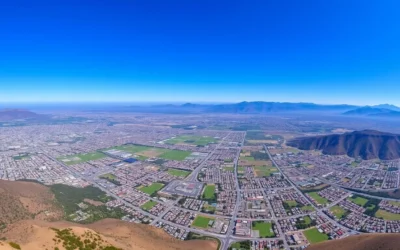✓ Accommodations ✓ Flights ✓ Rental Cars
You’re about to explore the linguistic diversity of California, a state that stands out as one of America’s most culturally rich regions. With over 200 languages spoken throughout the state, California’s linguistic landscape is as diverse as it is vibrant.
While English is the official state language, the reality is that many residents speak multiple languages. In fact, about 44% of Californians speak a language other than English at home, reflecting the state’s history of immigration and cultural exchange.
This diversity has shaped California into a unique cultural melting pot, with language playing a crucial role in everyday life, from education to business and government services.
California’s Linguistic Landscape
As the most populous state in the U.S., California boasts a rich tapestry of languages. With about 39 million residents, the state’s linguistic diversity is unmatched. The majority of people residing in California speak English, but a significant portion of the population speaks other languages at home.
A Melting Pot of Languages
California’s linguistic diversity is a result of its complex history and geographical position. Initially inhabited by Native Americans, the region saw significant changes with the arrival of European explorers, particularly Spanish missionaries and settlers. By 1833, 21 Spanish missions were established, leaving a lasting legacy on the state’s language landscape. Later, immigrants from various countries, including Japan, Mexico, and Russia, arrived in large numbers, further diversifying the linguistic environment.

Language Diversity Statistics
Statistics reveal the extent of California’s linguistic diversity. Approximately 43.9% of the population, or around 17.13 million residents aged four and above, speak a language other than English at home. This diversity is not limited to specific areas but is widespread across the state, with different communities establishing their own linguistic enclaves.
| Language Diversity Indicators | Statistics |
|---|---|
| Total Population | 39 million |
| Population speaking a language other than English at home | 43.9% |
| Number of residents speaking a language other than English | 17.13 million |
This diversity reflects broader demographic trends and continues to evolve with each new wave of immigrants, making California a uniquely diverse linguistic environment.
English: The Official Language of California
In the diverse linguistic landscape of California, English stands out as the primary language for communication. As the official language, it plays a crucial role in various aspects of life in California.
Legal Status and Policy
English has been officially recognized as the state language through Proposition 63, passed in 1986. This legislation has had significant implications for state policies, emphasizing the importance of English in official contexts.
The legal status of English as the official language has shaped the state’s approach to language use in government services, education, and public life. It ensures that English remains the language of communication for all official purposes.
English Usage Across the State
English is widely used across California, serving as the common language for people from diverse linguistic backgrounds. It is the primary language for business, education, and media, facilitating communication and integration.
- English is the dominant language in government services and public institutions.
- It is the primary language used in schools and universities.
- English proficiency is crucial for navigating daily life and accessing opportunities in California.
The widespread use of English has made it an essential tool for communication and social integration in California. As the state continues to grow and diversify, the role of English remains vital.
Spanish: California’s Most Widely Spoken Non-English Language
California’s linguistic landscape is significantly influenced by Spanish, which is spoken by approximately 28.34% of the population. With an estimated 10.51 million residents speaking Spanish, it’s clear that this language plays a vital role in the state’s cultural identity.
![]()
Historical Presence and Growth
The historical roots of Spanish in California date back to the Spanish colonial period and Mexico’s governance before the American acquisition in 1848. This legacy has contributed to the language’s persistence and growth, driven by ongoing immigration patterns and cultural ties to Mexico.
Spanish-Speaking Communities
Spanish-speaking communities are diverse and widespread across California. From long-established Mexican-American neighborhoods to more recent Central American immigrant enclaves, these communities have maintained their linguistic heritage while contributing to the state’s cultural richness.
Spanish in Public Life and Services
Spanish has become an integral part of California’s public life, with bilingual education programs, government services, media outlets, and business communications catering to the state’s Spanish-speaking population. This integration reflects the importance of Spanish in facilitating communication and providing services to a significant segment of the state’s residents.
| Language | Number of Speakers | Percentage of Population |
|---|---|---|
| Spanish | 10.51 million | 28.34% |
| English | Not specified | Majority |
The influence of Spanish is evident in various aspects of Californian life, from education to business. As the state’s immigrants continue to contribute to its cultural and economic fabric, the significance of Spanish is likely to endure.
Asian Languages in California
Asian languages play a significant role in California’s linguistic diversity. The state’s large and diverse Asian population has contributed to the presence of numerous Asian languages.

You’ll find that Chinese dialects, primarily Mandarin and Cantonese, are the second most common non-English language after Spanish. With approximately 1.26 million speakers, Chinese represents nearly 3.40% of the population. The Chinese language is widely spoken in cities like San Francisco and Los Angeles, where there are large Chinese communities.
Chinese (Mandarin and Cantonese)
The Chinese community in California is significant, with Mandarin and Cantonese being the most widely spoken dialects. These dialects are not only used in daily life but also in cultural and commercial contexts. San Francisco’s Chinatown is one of the largest and most well-known Chinese communities outside Asia.
Tagalog and Filipino
Tagalog is another prominent language in California, spoken by an estimated 780,024 people, which is about 2.10% of the population. The Filipino community is concentrated in areas like Daly City and parts of Los Angeles County. The presence of Tagalog reflects the significant Filipino population in the state.
Vietnamese
Vietnamese is spoken by around 556,398 residents, making up 1.50% of the population. The Vietnamese community is particularly notable in Orange County’s Little Saigon, which is the largest Vietnamese community outside Vietnam.
Korean
Approximately 358,018 Californians speak Korean, representing nearly 0.97% of the state’s population. The Korean language is centered in Los Angeles’ Koreatown and other enclaves throughout Southern California. The Korean community has established robust cultural and educational infrastructures.
The presence of these Asian languages reflects the diverse immigration patterns from Asia, from the early Chinese laborers during the Gold Rush era to the diverse Asian immigration following the 1965 Immigration Act. As a result, Asian languages are increasingly taught in California schools and universities, reflecting their growing importance in the state’s cultural and economic landscape.
California, United States: Official and widely spoken languages
California’s diverse population has given rise to a complex linguistic landscape, with many languages spoken alongside English. As you explore this aspect of the state’s cultural fabric, you’ll discover a rich tapestry of languages that reflect the various immigrant communities that have settled there.
Middle Eastern and South Asian Languages
California is home to a significant number of Middle Eastern and South Asian languages. Persian (including Farsi and Dari) is spoken by an estimated 211,089 California residents, making up almost 0.57% of the population. Arabic and Armenian are also widely spoken, with 198,914 and 195,413 speakers, respectively. The presence of these languages is largely due to the sizable immigrant communities from the Middle East and South Asia.
The communities that speak these languages have formed cultural centers in various parts of California. For instance, Glendale’s “Little Armenia” and Westwood’s “Tehrangeles” have become hubs for Armenian and Persian-speaking populations, respectively. You’ll find that these communities maintain their linguistic heritage through cultural events, religious institutions, and media outlets.
Hindi is another prominent language in California, with around 203,238 speakers, making it the seventh most widely spoken non-English language in the state. Other South Asian languages like Punjabi, Gujarati, and Urdu also have a significant presence.
![]()
European Languages
European languages continue to maintain their presence in California, albeit to a lesser extent than some of the other language groups. Russian is the tenth most widely spoken language in California, with about 170,508 speakers, making up an estimated 0.46% of the population. Other European languages like Italian, German, French, and Portuguese also have sizable communities.
These language communities have preserved their linguistic heritage through various means, including cultural organizations, religious institutions, and media outlets. The geographic distribution of these language groups varies, with some concentrated in urban centers and others in specific suburban enclaves.
| Language | Number of Speakers | Percentage of Population |
|---|---|---|
| Persian (including Farsi and Dari) | 211,089 | 0.57% |
| Hindi | 203,238 | 0.55% |
| Arabic | 198,914 | 0.54% |
| Armenian | 195,413 | 0.53% |
| Russian | 170,508 | 0.46% |
Indigenous and Native American Languages
You might not know that California was once home to nearly one-third of all Native American languages in the United States. The state’s indigenous peoples had a rich linguistic heritage, with over 90 distinct languages spoken across the region.
Historical Context
Initially, California was solely home to Native Americans, but the landscape began changing once Europeans started exploring the region. Native American populations declined sharply as they were exposed to diseases introduced by Europeans, and many others were subjugated or lost their lives through “pacification efforts.” California’s native languages belong to several major language families, including Uto-Aztecan, Penutian, Hokan, and Athabaskan, reflecting the region’s status as one of the most linguistically diverse areas in pre-colonial North America.
Current Status and Preservation Efforts
Today, many of California’s indigenous languages are considered endangered. However, there are efforts underway to preserve and revitalize these languages. Tribal communities are working with linguists and educators to teach their ancestral languages, such as Yurok, Karuk, Hupa, and Chumash. Educational institutions, from tribal schools to state universities, are incorporating indigenous language programs into their curricula. Digital technologies and documentation projects are also helping to preserve these languages for future generations.
Language preservation is closely tied to broader issues of cultural identity, sovereignty, and healing for California’s Native American communities. While there are challenges, the efforts across different tribal communities are yielding successes, demonstrating the resilience and determination of these communities to maintain their linguistic heritage.
Limited English Proficiency in California
Limited English proficiency affects a substantial number of Californians, impacting various aspects of their lives. Approximately 19.35% of California’s population, or around 7.55 million residents, are considered to have limited English proficiency (LEP), meaning they speak English “less than very well” according to census definitions.
Demographics and Statistics
The demographic data reveals that a significant portion of California’s population faces challenges due to limited English proficiency. Over 8% of the US population has LEP, with California being one of the states with the highest numbers. This demographic requires access to language assistance services to navigate everyday life, including healthcare, education, and government services.
Challenges and Support Systems
Individuals with LEP face numerous challenges, including accessing healthcare services, understanding educational materials, and participating in civic activities. To address these challenges, federal and state laws, such as Title VI of the Civil Rights Act and California’s Dymally-Alatorre Bilingual Services Act, mandate the provision of language access services, including interpretation and translation services. Hospitals, for instance, are required to translate vital documents into the 15 most common languages in their service areas.
By understanding the demographics and challenges associated with LEP, California can better implement support systems to ensure equal access to services for all residents.
Conclusion: The Future of Linguistic Diversity in California
The linguistic diversity in California is not just a demographic characteristic; it’s a driving force behind the state’s economic and cultural vibrancy. As you navigate the complexities of this multilingual landscape, it’s essential to recognize the benefits of embracing the many languages spoken in the state.
For businesses, this means leveraging translation and localization services to reach diverse markets and expand their customer base. In healthcare and government sectors, providing multilingual services ensures that all communities have access to essential services. As technology continues to advance, real-time translation apps and AI-powered content localization tools are making communication across language barriers more seamless.
By embracing linguistic diversity, you can develop valuable cross-cultural communication skills, enhance your business’s global reach, and contribute to creating a more inclusive environment in California. As the state’s demographics continue to evolve, it’s crucial to prioritize language access and translation to bridge the communication gap.
The above is subject to change.
Check back often to TRAVEL.COM for the latest travel tips and deals.





